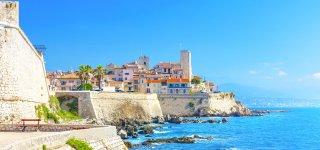The town of Antibes
Already inhabited in the Iron Age, the territory of Antibes retains traces of a major interchange with the ancient Greeks. The foundation of Antipolis, Marseille the colony of Marseille, date from the 4th century BC. The territory is administered by the Greeks until the middle of the first century BC, when Caesar takes the Marseilles colony after his victory over Pompey . First autonomous community and city Antipolis will be integrated into Narbonensis.
Many relics show that Antibes was quickly equipped buildings and essential equipment of any Roman town: two aqueducts to carry water, an amphitheater and several large family villas.
The two defensive towers of Antibes from the Middle Ages. From the 10th to 15th century, the city passed successively from the hands of the family of Grasse to those of the Grimaldi family. It is however in the 16th and 17th century were built the walls around the city. important port on the border of the Kingdom of France, Antibes is a privileged gateway to Provence, including ease of access is a threat to the risks of invasion. Under the reign of François 1st, it suffers from the Charles V twice. The fortification of the city begins with the construction of Fort Square under Henry II. In the early 17th century, the bastioned ramparts Italian are built in Henry IV initiative. In the second half of the century, the pier, the old harbor channel and the bastion of the port will also emerge.
In the 19th century, with urban growth of Antibes and the birth of the seaside resort of Juan-les-Pins, the gradual dismantling of the city walls was imposed.
Today world-renowned Antibes is a popular destination for its 23 km of coastline, four ports, the old town has preserved its charm, its cultural vitality and its infinite leisure offer. Labeled for the quality of its beach and port facilities, it hosts major nautical events like the Voiles d'Antibes, the Antibes Yacht Show Lounge or the Blue Cruise.
Dynamic and forward-looking, Antibes houses a large part of European technology park Sophia Antipolis, France and most of Europe. It also hosts major cultural events throughout the year: music festivals, art exhibitions, as living art performances.
Among the best sights and many places of interest in Antibes include natural areas of exception as the Cap d'Antibes and the Tire-Poil path along its coastline. The battery Graillon, former military site, now home to a museum dedicated to the discovery of sensitive areas and their conservation. The site also houses a marine turtle care center.
The Provencal market of the city, very famous, helps make Antibes a privileged place of preservation of tradition and culture of Provence.
Several museums are also to visit in the old town, between naps on the beaches of Juan-les-Pins: the Picasso Museum in Grimaldi Castle, the Archaeological Museum which houses the famous Stone of Terpon engraved with one of oldest Greek inscriptions discovered in Gaul, the Peynet museum dedicated to the cartoon, and the museum of the postcard.
Among the built heritage of the city, are not to miss the Fort Carré, Port Vauban which is one of the largest marinas in Europe, and the lighthouse of Garoupe.
Marineland, created in 1970, consists of a water theme park and a marine zoo. Most visited site in the region, it is emblematic of Antibes.
